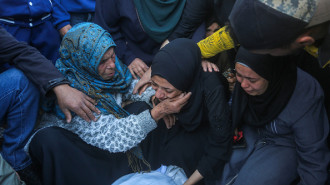Israeli aid restrictions had 'direct impact' on Gaza hunger levels
Israel's restrictions on aid flows into Gaza and its destruction of food facilities had a direct impact on famine conditions for the enclave’s population throughout the past eleven months of war, a new report has found.
Palestinians have been subject to famine-like conditions and been forced into negative coping mechanisms "symptomatic of famine situations," according to a new report on Gaza’s hunger crisis.
The report by NGO Refugees International sheds light on Israel’s "counter-narrative" of downplaying and denying the existence of a hunger crisis in the devastated Strip, which was promoted by senior Israeli government and military figures.
Aid agencies, including the United Nations, have repeatedly called on Israel to allow full humanitarian access throughout the dense enclave and to drop restrictions on the entry of certain items.
Many Palestinian families have said they only eat one meal a day with parents often skipping meals to let their children eat instead. Others have reported eating animal food and tree leaves out of desperation.
Refugees International's 25-page report published on Thursday found that the "ebbs and flows in hunger conditions are closely linked to Israeli government restrictions and concessions on aid access and to the conduct of the Israeli military".
The scale of the hunger crisis has been amplified by a multifaceted destruction to the enclave’s food system, included the breakdown of Gaza’s private sector which was the main source of goods for residents prior to the war.
Now the majority of the 2.3 million population are dependent on handouts for daily needs.
The UN-backed International Phase Classification, which measures hunger crises globally. estimates that 96 percent of Gaza’s population is projected to face “crisis or worse levels of food insecurity” this year.
Health officials estimate that some 50,000 children are in need of treatment for acute malnutrition, while 96 percent of women and children under two years are not meeting nutrient requirements.
Refugees International warned that without long term aid access and guaranteed civilian and humanitarian safety, the risk of famine-like conditions spiralling downwards remains.
The report cites interviews with numerous stakeholders in the Gaza aid system, including Israeli and Jordanian government officials, Palestinians inside Gaza and those evacuated, as well as aid workers.
It highlighted that the destruction of Gaza’s food production as key cause of the proliferation of major food shortages. Damage to wheat mills and agricultural fields hampered Gaza’s traditional food sovereignty while it made it difficult to turn donated sacks of flour into bread.
The UN estimates that around 70 percent of meat and dairy producing livestock has been killed or prematurely slaughtered and 68 percent of farmland destroyed.
The report also scrutinizes an Israeli government study on hunger conditions in Gaza that served to appease international concerns over the humanitarian crisis.
It cites a draft nutrition paper compiled by Israeli academics, which argued that sufficient volumes of food has entered Gaza, contrary to the concerns and testimonies of numerous respected NGOs and the IPC reports.
Refugees International found that the report, which is not peer reviewed nor published in an academic journal, has clear gaps as it only analyses a four-month time period.
The charity also said that the paper’s authors have "declined to share it with outside academics when asked".
Over the course of the eleven-month war, some 90 percent of Gaza’s population have been displaced several times, often at the command of Israel’s military.
Another key aspect that contributed to the hunger crisis in Gaza’s north accelerated after Israel imposed a blockade along Wadi Gaza, which divided the strip through the centre and blocked access for aid trucks.
The UN has reported numerous instances in which their convoys were blocked from accessing northern towns despite growing reports of malnutrition with desperately hungry residents being forced to eat animal feed and leaves.
Even after international pressure forced Israel to open a second border crossing and allow commercial items into the Strip in April, it did not sufficiently work to alleviate hunger threats.
The report noted that items like cigarettes, fizzy drinks and sweets were among the goods entering the strip, none of which are suitable to treat a humanitarian crisis.
As far back as December, the IPC warned that parts of north Gaza were at risk of famine, but nothing was done to heed the deterioration until conditions worsened over the winter months, the report said.
At least at least 34 people, most of whom are children, have already died from severe malnutrition, according to the health ministry in Gaza.




 Follow the Middle East's top stories in English at The New Arab on Google News
Follow the Middle East's top stories in English at The New Arab on Google News
![A group of Palestinians, foreign and Israeli activists gather to participated in an olive picking event on the land in the town of Battir, which is under threat of confiscation by Israel in Bethlehem, occupied West Bank on 8 November 2024. [Getty]](/sites/default/files/styles/image_330x185/public/2182930803.jpeg?h=199d8c1f&itok=__0LgGsa)

![People gathered around the rubble of destroyed houses to search for survivors [Getty]](/sites/default/files/styles/image_330x185/public/2024-11/GettyImages-2184733820.jpg?h=199d8c1f&itok=NiM1LO2f)